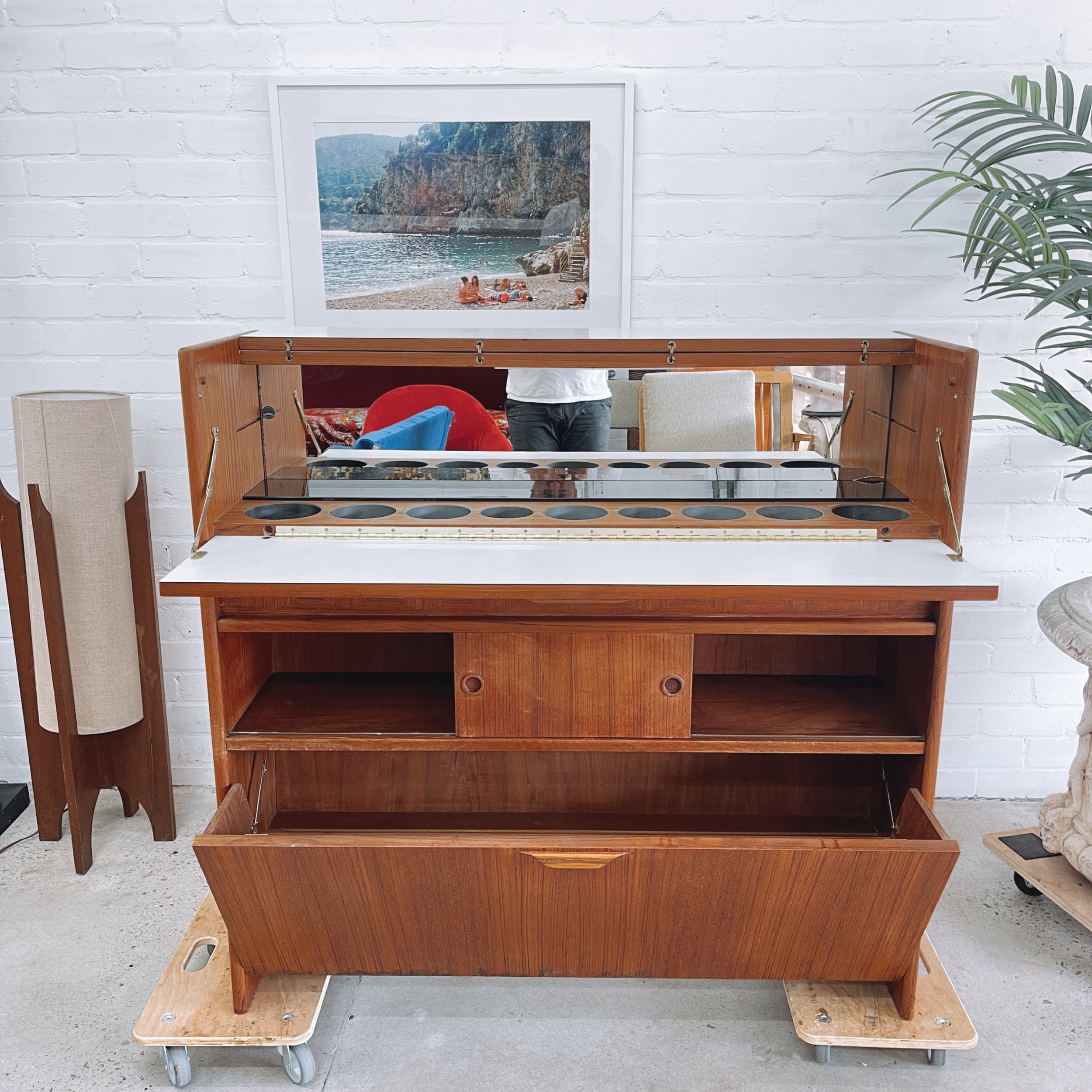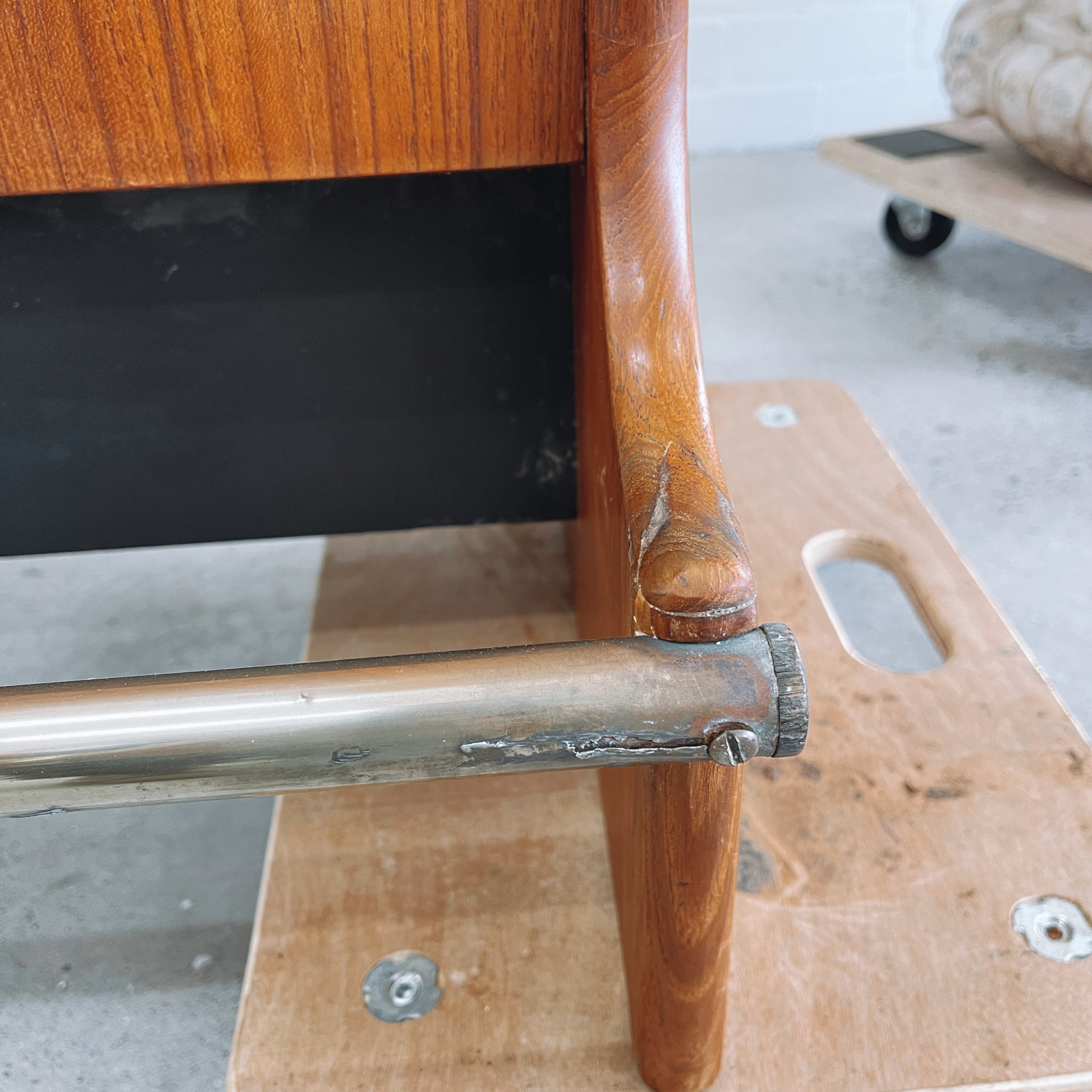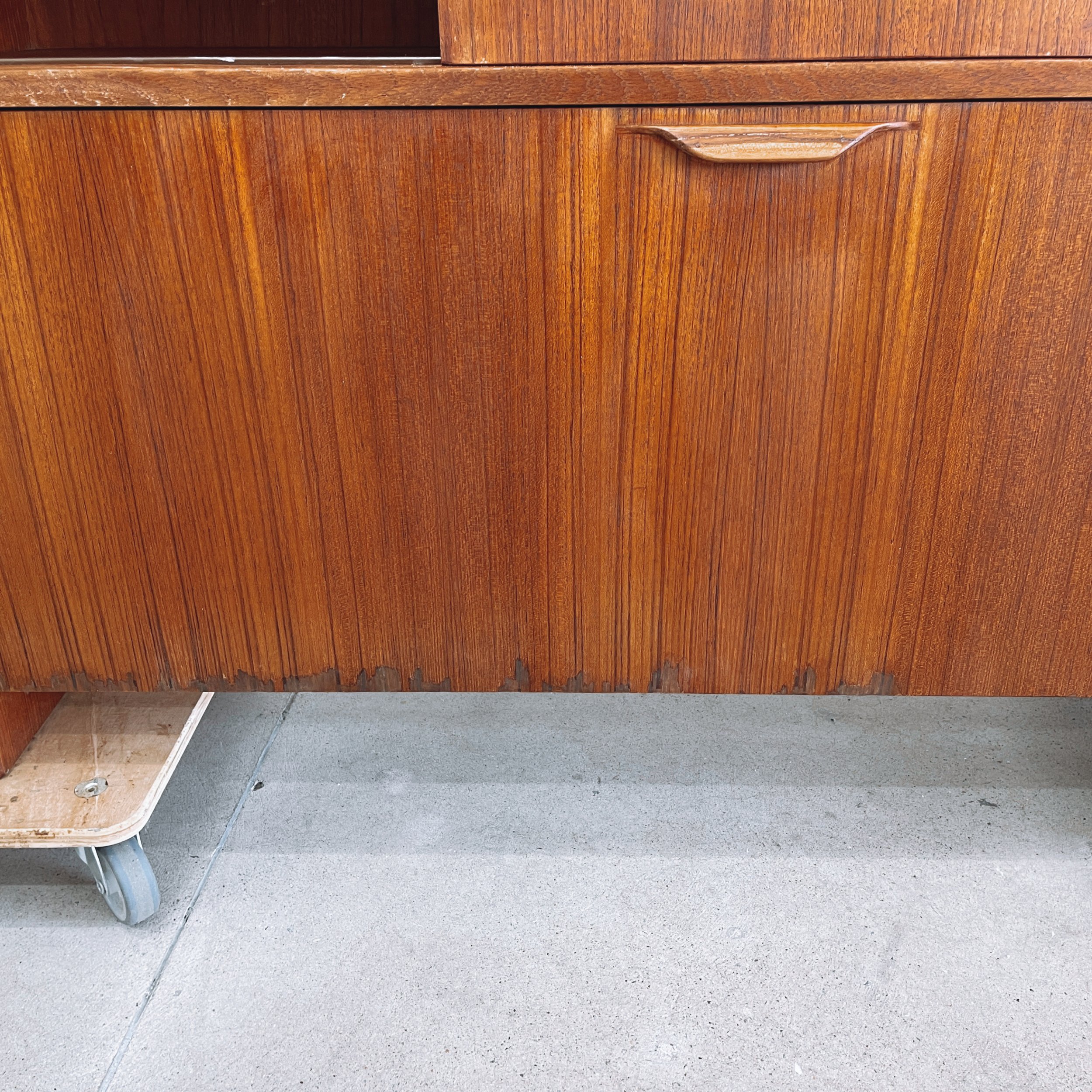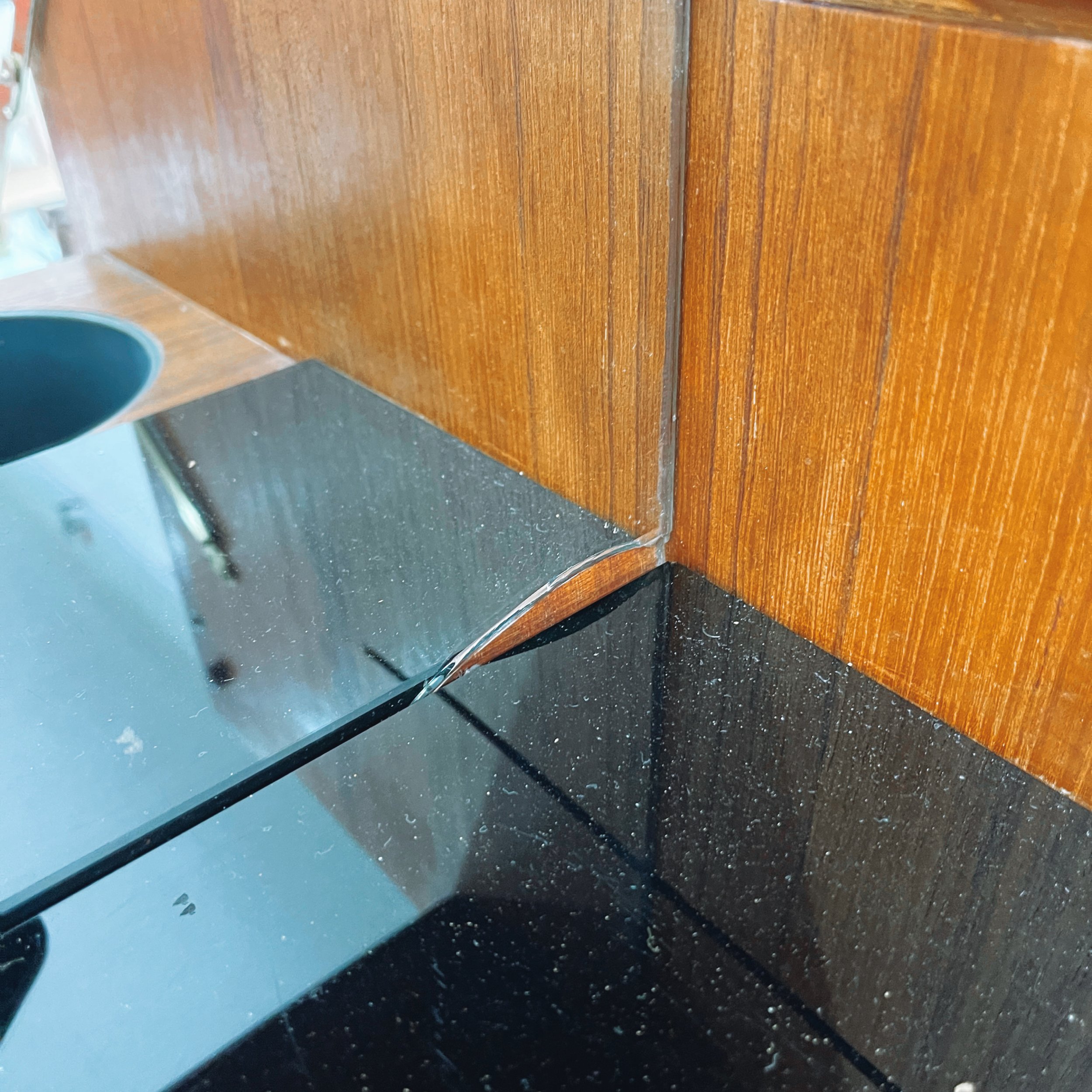1950s ARNE JACOBSEN 'ANT' CHAIR
Simplistic and beautiful, this original 1950s Arne Jacobsen for Fritz Hansen ‘Ant’ chair is a perfect representation of one of the finest designers of the mid-century period.
A 1st edition, it comes with the original painted steel three legged base and curved teak seat. In original condition featuring lovely unique patina from its 70 years in service.
A very rare, collectible and sculptural art piece to be showcased in any living, office or bedroom space.
Available to inspect at our Alexandria Studio. Please contact us should you have any questions about this or any of our available pieces.
Dimensions:
Width 56 cm x Depth 53 cm x Height 75 cm & Seat Height 44 cm
_____________
The Designer: Arne Jacobsen
Born in Copenhagen in 1902, Arne Jacobsen apprenticed as a bricklayer before studying architecture at the Royal Danish Academy of the Arts. In 1925, he participated in the Exposition Internationale des Arts Décoratifs in Paris, and subsequently travelled to Germany. During this formative trip, he came under the influence of Le Corbusier, Walter Gropius, and Ludwig Mies van der Rohe.
Prior to World War II, Jacobsen designed a number of private and public buildings in Denmark and, in the process, helped to formulate what would eventually be called the Danish Modern style. In 1943, he fled Denmark for Sweden, where he found work designing fabrics and wallpapers, but he returned home after the war. In the ensuing decades, Jacobsen became the most dominant figure in Danish architecture. Inspired greatly by Charles Eames, he began to design furniture for his interiors, such as the iconic Swan Chair and Egg Chair.
The Maker: Fritz Hansen
Danish cabinetmaker Fritz Hansen founded his eponymous furniture manufacturing company with his son Christian in Copenhagen in 1885. The first three decades were dedicated to hand-making wood and iron frames for upholstered furniture. In 1915, however, Christian began to introduce industrial processes, such as steam-bending wood, which enabled the family business to mass-produce at a larger scale.
In 1932, Christian brought in his own sons, Fritz and Søren, who updated the product line to include more modernist styles, like Søren’s Thonet-inspired DAN Chair (1930) and a cantilevered wicker and tubular steel chair by architect Mogens Lassen (1933). Other early classics in the Fritz Hansen catalog include Kaare Klint’s Church Chair (1936), Hans Wegner’s China Chair (1944), and Børge Mogensen’s Spoke Back Sofa (1945).
During the 1950s—thanks especially to the contributions of architect Arne Jacobsen—Fritz Hansen entered its golden era, creating some of the most iconic Scandinavian designs of the 20th century. Arne Jacobsen’s Ant Chair (1952), Swan Sofa (1958) and Egg Chair & Ottoman (1958), as well as later designs by Verner Panton, Piet Hein, and Grete Jalk, all helped to cement Fritz Hansen’s legacy as one of the most beloved producers of high quality, simple-yet-elegant, Danish modern furniture.
In 1979, after 107 years of family ownership, Fritz Hansen was bought out by Skandinavisk Holding and is now known as The Republic of Fritz Hansen. Pieces from the company’s long history can be found in nearly every design museum collection there is, from MoMA and Cooper Hewitt in New York to the Powerhouse Museum in Sydney. Arne Jacobsen’s collaboration with Fritz Hansen was the subject of the Siéntate Siéntete exhibition, hosted by the Chamber of Architects in Madrid in 2010.
Simplistic and beautiful, this original 1950s Arne Jacobsen for Fritz Hansen ‘Ant’ chair is a perfect representation of one of the finest designers of the mid-century period.
A 1st edition, it comes with the original painted steel three legged base and curved teak seat. In original condition featuring lovely unique patina from its 70 years in service.
A very rare, collectible and sculptural art piece to be showcased in any living, office or bedroom space.
Available to inspect at our Alexandria Studio. Please contact us should you have any questions about this or any of our available pieces.
Dimensions:
Width 56 cm x Depth 53 cm x Height 75 cm & Seat Height 44 cm
_____________
The Designer: Arne Jacobsen
Born in Copenhagen in 1902, Arne Jacobsen apprenticed as a bricklayer before studying architecture at the Royal Danish Academy of the Arts. In 1925, he participated in the Exposition Internationale des Arts Décoratifs in Paris, and subsequently travelled to Germany. During this formative trip, he came under the influence of Le Corbusier, Walter Gropius, and Ludwig Mies van der Rohe.
Prior to World War II, Jacobsen designed a number of private and public buildings in Denmark and, in the process, helped to formulate what would eventually be called the Danish Modern style. In 1943, he fled Denmark for Sweden, where he found work designing fabrics and wallpapers, but he returned home after the war. In the ensuing decades, Jacobsen became the most dominant figure in Danish architecture. Inspired greatly by Charles Eames, he began to design furniture for his interiors, such as the iconic Swan Chair and Egg Chair.
The Maker: Fritz Hansen
Danish cabinetmaker Fritz Hansen founded his eponymous furniture manufacturing company with his son Christian in Copenhagen in 1885. The first three decades were dedicated to hand-making wood and iron frames for upholstered furniture. In 1915, however, Christian began to introduce industrial processes, such as steam-bending wood, which enabled the family business to mass-produce at a larger scale.
In 1932, Christian brought in his own sons, Fritz and Søren, who updated the product line to include more modernist styles, like Søren’s Thonet-inspired DAN Chair (1930) and a cantilevered wicker and tubular steel chair by architect Mogens Lassen (1933). Other early classics in the Fritz Hansen catalog include Kaare Klint’s Church Chair (1936), Hans Wegner’s China Chair (1944), and Børge Mogensen’s Spoke Back Sofa (1945).
During the 1950s—thanks especially to the contributions of architect Arne Jacobsen—Fritz Hansen entered its golden era, creating some of the most iconic Scandinavian designs of the 20th century. Arne Jacobsen’s Ant Chair (1952), Swan Sofa (1958) and Egg Chair & Ottoman (1958), as well as later designs by Verner Panton, Piet Hein, and Grete Jalk, all helped to cement Fritz Hansen’s legacy as one of the most beloved producers of high quality, simple-yet-elegant, Danish modern furniture.
In 1979, after 107 years of family ownership, Fritz Hansen was bought out by Skandinavisk Holding and is now known as The Republic of Fritz Hansen. Pieces from the company’s long history can be found in nearly every design museum collection there is, from MoMA and Cooper Hewitt in New York to the Powerhouse Museum in Sydney. Arne Jacobsen’s collaboration with Fritz Hansen was the subject of the Siéntate Siéntete exhibition, hosted by the Chamber of Architects in Madrid in 2010.
Simplistic and beautiful, this original 1950s Arne Jacobsen for Fritz Hansen ‘Ant’ chair is a perfect representation of one of the finest designers of the mid-century period.
A 1st edition, it comes with the original painted steel three legged base and curved teak seat. In original condition featuring lovely unique patina from its 70 years in service.
A very rare, collectible and sculptural art piece to be showcased in any living, office or bedroom space.
Available to inspect at our Alexandria Studio. Please contact us should you have any questions about this or any of our available pieces.
Dimensions:
Width 56 cm x Depth 53 cm x Height 75 cm & Seat Height 44 cm
_____________
The Designer: Arne Jacobsen
Born in Copenhagen in 1902, Arne Jacobsen apprenticed as a bricklayer before studying architecture at the Royal Danish Academy of the Arts. In 1925, he participated in the Exposition Internationale des Arts Décoratifs in Paris, and subsequently travelled to Germany. During this formative trip, he came under the influence of Le Corbusier, Walter Gropius, and Ludwig Mies van der Rohe.
Prior to World War II, Jacobsen designed a number of private and public buildings in Denmark and, in the process, helped to formulate what would eventually be called the Danish Modern style. In 1943, he fled Denmark for Sweden, where he found work designing fabrics and wallpapers, but he returned home after the war. In the ensuing decades, Jacobsen became the most dominant figure in Danish architecture. Inspired greatly by Charles Eames, he began to design furniture for his interiors, such as the iconic Swan Chair and Egg Chair.
The Maker: Fritz Hansen
Danish cabinetmaker Fritz Hansen founded his eponymous furniture manufacturing company with his son Christian in Copenhagen in 1885. The first three decades were dedicated to hand-making wood and iron frames for upholstered furniture. In 1915, however, Christian began to introduce industrial processes, such as steam-bending wood, which enabled the family business to mass-produce at a larger scale.
In 1932, Christian brought in his own sons, Fritz and Søren, who updated the product line to include more modernist styles, like Søren’s Thonet-inspired DAN Chair (1930) and a cantilevered wicker and tubular steel chair by architect Mogens Lassen (1933). Other early classics in the Fritz Hansen catalog include Kaare Klint’s Church Chair (1936), Hans Wegner’s China Chair (1944), and Børge Mogensen’s Spoke Back Sofa (1945).
During the 1950s—thanks especially to the contributions of architect Arne Jacobsen—Fritz Hansen entered its golden era, creating some of the most iconic Scandinavian designs of the 20th century. Arne Jacobsen’s Ant Chair (1952), Swan Sofa (1958) and Egg Chair & Ottoman (1958), as well as later designs by Verner Panton, Piet Hein, and Grete Jalk, all helped to cement Fritz Hansen’s legacy as one of the most beloved producers of high quality, simple-yet-elegant, Danish modern furniture.
In 1979, after 107 years of family ownership, Fritz Hansen was bought out by Skandinavisk Holding and is now known as The Republic of Fritz Hansen. Pieces from the company’s long history can be found in nearly every design museum collection there is, from MoMA and Cooper Hewitt in New York to the Powerhouse Museum in Sydney. Arne Jacobsen’s collaboration with Fritz Hansen was the subject of the Siéntate Siéntete exhibition, hosted by the Chamber of Architects in Madrid in 2010.























































